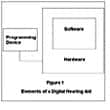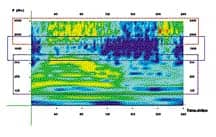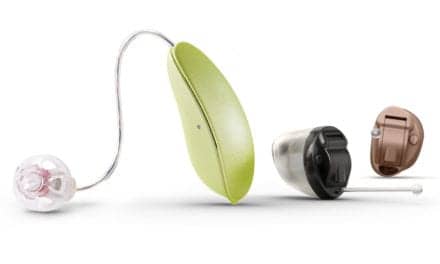
MarkeTrak research1 conducted by Knowles Electronics demonstrated that the average programmable hearing instrument outperforms the typical hearing instrument by 10 percentage points in overall customer satisfaction. This finding supports previous consumer research.2-7 Specifically, hearing instrument products with multiple memories, multiple channels and multiple microphones have been shown to positively impact the consumer’s experience sometimes by as much as 30 customer satisfaction (%) points on certain customer satisfaction variables.
While a wide variety of solutions to hearing in noise have been proposed8, it would appear that multiple microphone digital hearing instruments offer the greatest promise for satisfying the consumer’s needs in noisy and difficult listening situations.9 Two studies have shown that multiple microphone hearing instruments have the ability to more than double customer satisfaction in some noisy and difficult listening situations (as compared to national MarkeTrak norms).6,7 With the advent of digital signal processing (DSP) technology, there is also the possibility that noise sources—both internal and external—to the hearing instrument can be reduced, making it possible for the end-user to capture and understand more of the speech signal.10 Digital signal processing, combined with multiple microphone technology, holds the promise of providing a significant leap in comfort in noise, as well as speech intelligibility in noise, for hearing-impaired individuals.
DSP hearing instruments now garner 18% of the U.S. hearing instrument market.11 With the exception of smaller unpublished studies, no large-sample study (to the author’s knowledge) has been conducted on consumer reactions to the new digital technology. This study is meant to help fill that void and to contribute to our continued dialogue on customer satisfaction with the hearing industry’s products and services.

Survey Method
As in past customer satisfaction studies conducted by Knowles Electronics, specific manufacturers of digital hearing instruments were asked to recruit dispensing professionals to send out Knowles’ MarkeTrak surveys to consumers of digital hearing instruments within the past year. Dispensers were given detailed instructions for selecting unbiased samples of customers to participate in this study, as well as a package containing a letter from the manufacturer, a MarkeTrak survey and a self-addressed envelope for returning the survey. The dispensing professional was asked to simply fill in the name and address of their customers on the envelope. Both the consumer and dispenser were given incentives to participate in this survey. All completed surveys were returned to Knowles for keypunching and analysis.
The core of the MarkeTrak survey consists of 45 ratings of customer satisfaction with hearing instruments and hearing health services. Four items are behavioral in nature (hours worn, extent to which the consumer would recommend hearing aids, recommend the dispenser and repurchase the current brand of hearing aid), one item is a quality-of-life rating and 40 items are rated on a five-point Likert scale taking the values “very dissatisfied,” “dissatisfied,” “neutral,” “satisfied” and “very satisfied.” In addition to an overall hearing aid satisfaction rating, MarkeTrak measures satisfaction with eight product features, 12 performance/value factors, six dispenser attributes and in 13 listening situations. The reader is referred to the most recent MarkeTrak publication for further details.1
As shown in Table 1, close to 500 customer satisfaction surveys were returned: 200 were single omni-directional microphone digital hearing instruments and 296 were multiple microphone digital hearing instruments. With respect to the multiple microphone sample, all were phase- and sensitivity-matched paired omni-directional Knowles Electronics microphones. In addition, the end-user had control, via a switch on the hearing instrument, of listening in omni-directional or directional modes.
All surveys were conducted in the United States from a single European-based manufacturer. The average age for the digital hearing instruments was slightly more than six months. The MarkeTrak norm group of 418 (hearing instruments between 3-12 months of age, excluding CIC hearing aids) was derived from the Knowles MarkeTrak V database (1997). The digital users in the study (i.e., digital samples) tended to be slightly older, significantly more affluent (incomes 40-56% higher than MarkeTrak), with higher degrees of hearing loss (multiple microphone sample only) and a higher incidence of binaural fittings (10-11% points higher than MarkeTrak). The digital sample was less likely to receive third-party reimbursement for their hearing instruments (19-22% versus 29% for MarkeTrak) and respectively paid 272% (single microphone) and 260% (multiple microphone) of the average hearing instrument market price ($767 excluding CICs and including free hearing aids). The multiple microphone sample was composed of 69% BTEs and 31% ITEs, while the single microphone sample was composed of 44% ITEs and 56% ITCs.
Results and Discussion
Customer satisfaction and dissatisfaction are documented in Table 2 for the MarkeTrak, single microphone digital and multiple microphone digital samples followed by the customer satisfaction difference scores between each of the samples. In Table 3, the mean scores are reported for each of the samples, as well as statistical significance test results between the three samples. In evaluating the results, it is important to keep in mind the top factors impacting overall satisfaction (see the last column of Table 3). In rank order, these are:
- Benefit (improved hearing);
- Clarity of sound;
- Value (price relative to performance);
- Reliability;
- Use of hearing instrument in leisure activities;
- Natural sounding;
- Use in noisy situations;
- Use in large group situations;
- Use in restaurants, and
- Use outdoors.
All variables with at least a 10% improvement in ratings due to digital or matched multiple microphone technology are graphed in Fig. 1.
þ Overall Satisfaction Factors: Table 2 indicates that 61% of consumers are satisfied with their hearing instruments (MarkeTrak, all instruments) compared to 64% for single microphone digital hearing instruments and 78% for multiple microphone digital instruments. With respect to consumer behavior variables, both single and multiple microphone digital hearing instruments are rated significantly higher than MarkeTrak on hours the hearing instrument is worn, repurchase likelihood and the likelihood of recommending the dispenser who fit the hearing instruments. In addition, multiple microphone instruments are rated higher on quality of life and likelihood of recommending hearing instruments to a friend. Multiple microphone digital instruments are also rated significantly higher than single microphone digital instruments on overall satisfaction (78% versus 64%), quality of life (82% versus 72%) and hours worn per day (11.9 versus 10.8).
þ Product Features: Single microphone products are rated higher than MarkeTrak and multiple microphone products on visibility. However, multiple microphone products are rated higher than MarkeTrak on ease of battery change and on-going expense; the latter is also higher than single microphone product. Both digital products are rated significantly lower (42% and 37% points respectively) on ease of adjusting volume.
All of the devices in this study should be considered as having automatic volume controls, meaning the signal processing circuitry make decisions for the consumer as to the level of gain necessary across listening environments. None of the product in this study had manual volume controls. Yet, as shown in Fig. 2, 28% of single microphone consumers and 35% of multiple microphone consumers indicated that they wanted a volume control.
The availability of a VC could dramatically impact overall customer satisfaction, as demonstrated in Fig. 3. Consumers who are pleased with the automatic VC feature (e.g., they do not desire a VC) report overall customer satisfaction ratings of 81% (single mic sample) and 93% (multiple mic sample) compared to 42% and 60% for consumers who desire a VC. Individuals who indicate they are “not sure,” report customer satisfaction ratings of 57% and 79%.
þ Performance/Value Factors: Single microphone digital hearing instruments were rated equal to the typical hearing instrument (MarkeTrak) on all factors in this category with the exception of satisfaction with value and sound of voice, on which they are rated significantly lower. Multiple microphone digital hearing instruments were rated significantly higher than the typical hearing instrument on 7-of-12 factors in this category: battery life, benefit, clarity of sound, natural sounding, feedback, comfort with loud sounds and use in noisy situations. They are, however, also rated significantly lower on value.
Multiple microphone digital hearing instruments are rated significantly higher than single microphone digital hearing aids on five factors: battery life, benefit, clarity of sound, sound of voice and use in noisy situations. The most important of these factors are benefit, sound quality and use in noise.
þ Listening Environments: Single microphone digital hearing instruments are rated equal to MarkeTrak on 12-of-13 listening situations and lower on use in a restaurant. Multiple microphone digital hearing instruments are rated higher than MarkeTrak on 4-of-13 listening situations and higher than single microphone product on five listening situations including: one-on-one in quiet, small groups, outdoors, restaurant and large group situations.
Multiple environment listening utility (MELU) has been previously shown to be critical for delighting consumers.1 Overall customer satisfaction and benefit are highly related to the number of listening situations in which the consumer has a satisfying listening experience (e.g., improved speech intelligibility in a restaurant, pleasurable experience listening to music or reduced aversiveness of sounds). We have estimated that the consumer must be satisfied in slightly more than 50% of his/her listening situations to rate a hearing aid at the 90% satisfaction level on benefit; they must be satisfied in 85% of the listening situations to give a 90% overall satisfaction rating to the hearing aid.
þ Dispenser Service: The dispenser of single and multiple microphone digital hearing instruments was rated higher than the hearing instrument specialist or audiologist dispensing the typical hearing instrument product. Single and multiple microphone products are equivalent on dispenser ratings.



Summary Findings
- Single microphone (omni-directional) digital hearing instruments were rated higher than MarkeTrak on 4-of-39 variables (not including the dispenser ratings). None of these factors made the top-10 list of factors most correlated with overall consumer satisfaction.
- Multiple microphone (directional) digital hearing aids were rated 17% points higher on consumer satisfaction, as well as higher on 18-of-39 factors (not including the dispenser ratings).
- Multiple microphone digital hearing instruments were rated higher than single microphone product by 14% points on overall customer satisfaction, on 14-of-39 MarkeTrak variables including six of the top-10 factors impacting overall customer satisfaction, as well as 5-of-13 listening situations. The fact that the multiple microphone sample was composed of nearly 70% BTE users is even more impressive, since previous research has shown that BTE users are more critical of their hearing aids.1
- Multiple microphone digital hearing instruments showed double-digit customer satisfaction improvements on 14 customer satisfaction variables compared to four for single microphone digital instruments (See Fig. 1).
- Dispensers of digital technology were rated superior to the dispenser of typical hearing aids.
- Close to one-third of digital hearing instrument consumers indicate that they want a volume control. The data strongly suggests that there are probably segments of users for which VCs should be provided. In these instances where it is desired, the lack of a VC could severely impact customer satisfaction ratings. Currently, there is about a 30% difference in customer satisfaction ratings between consumers who desire a VC and consumers who do not desire one (that is, those consumers who are satisfied with an automatic VC, have much higher satisfaction scores). The lack of a VC, coupled with the increased price of digital hearing instruments, has likely suppressed customer satisfaction ratings.
Conclusions
Single microphone (omni-directional) digital hearing instruments would appear to be equivalent, in a multivariate sense, to the typical analog hearing instrument on the market with respect to customer satisfaction. Multiple microphone (directional) digital hearing instruments, while they are still rated lower on value, achieve overall customer satisfaction ratings 17% higher than MarkeTrak and 14% higher than the single microphone digital product. In comparison, in a previous study conducted by this author2, multiple microphone programmable analog products were rated 13% higher than a large sample of digitally programmable analog products, and 26% higher than MarkeTrak.
It should be pointed out that, in the author’s opinion, the difference between the styles of the multiple microphone (69% BTE, 31% ITE) and the single microphone (56% ITC, 44% ITE) digital samples is unlikely to have had a large impact on the satisfaction ratings in this study. MarkeTrak V1 shows that overall satisfaction with hearing instrument styles are 56-66% for ITCs, 57-58% for ITEs and 61% for BTEs. It is apparent from the range of these scores that the style of instruments is unlikely to account for the significant differences in overall satisfaction between the single and multiple microphone digital samples. It is possible, however, that the instrument styles could have some impact on the individual sample responses in areas like the wearing of the hearing instrument and battery life—items in which BTEs scored higher than other styles in the MarkeTrak study. However, it should be noted that BTEs compared less favorably to other MarkeTrak instrument parameters, such as the ability to hear soft sounds, listening in small and large groups, listening to music and in places of worship—lending further credence to this study’s findings.
Additionally, it should be acknowledged that this study used only one manufacturer’s hearing instrument technology. While it can be argued that this provides a good control, upcoming research on digital instruments across several technology platforms promises to provide more information on the application of, and interaction between, digital signal processing, directional microphones, noise reduction strategies, volume control options and other product features.
Considering this present study and a review of the literature, it appears that multiple microphone products distinguish themselves by having the ability to impact appreciably user satisfaction in noisy or difficult listening situations. Since performance in noise is one of the main barriers to growth of the hearing aid market12,13 —the #1 hearing aid feature desired by current end-users14 and the second most-frequent reason why close to a million hearing aids are in the drawer in the United States15—it would appear to be in the best interests of the worldwide hearing care industry to fit the majority of end-users with multiple microphone technology, therefore increasing the likelihood that consumers will derive more value and utility from their hearing instruments. w
References
1. Kochkin S: MarkeTrak V: Customer satisfaction revisited. Hear Jour 1999; 52 (1): 33-48.
2. Kochkin S: Customer satisfaction and subjective benefit with high-performance hearing instruments. Hearing Review 1996; 3 (12): 16-26.
3. Jedidi K. & Estelami H: Measuring user satisfaction with programmables. Hear Instrum 1994; 45 (5): 22-23.
4. Whichard S: Auditory benefits of ReSound sound processing technology. Sem Hear 1997; 18 (1): 63-66.
5. Sandridge S: Customer satisfaction with MultiFocus hearing aids. Sem Hear 1997; 18 (1): 67-72.
6. Kuk F: Hearing aid survey tests user satisfaction. Hear Instrum 1996; 47 (1): 24-29.
7. Schuchman G, Valente M, Beck LB & Potts L: User satisfaction with an ITE directional hearing aid. Hearing Review 1999; 6 (7): 12-22.
8. Agnew J: Challenges and some solutions for understanding speech in noise. In S Kochkin & KE Strom’s (eds.) High Performance Hearing Solutions, Vol. 3, Hearing in Noise. Hearing Review 1999; (Suppl) 6 (1): 4-9.
9. Valente M, Sweetow R & May A: Using multiple microphone technology to improve speech recognition. In S Kochkin & KE Strom’s (eds.) High Performance Hearing Solutions, Vol. 3, Hearing in Noise. Hearing Review 1999; (Suppl) 6 (1)14-25.
10. Powers T, Holube I & Wesselkamp M: The use of digital features to combat background noise. In S Kochkin & KE Strom’s (eds.) High Performance Hearing Solutions, Vol. 3, Hearing in Noise. Hearing Review 1999; (Suppl) 6 (1): 36-39.
11. Hearing Industries Association (HIA): Quarterly Statistics Report for the Second Quarter 2000. Washington , D.C.: HIA, Jul 18, 2000.
12. Kochkin S: MarkeTrak IV: Correlates of hearing aid purchase intent. Hear Jour 1998; 51 (1): 30-41.
13. Kochkin S: MarkeTrak III: Why 20 million in U.S. don’t use hearing aids for their hearing loss. Hear Jour 1993; 46 (1): 20-27; 46 (2): 26-31; 46 (4): 36-37.
14. Stock A, Fichtl E & Heller O: Comparing determinants of hearing instrument satisfaction in Germany and the United States. In S Kochkin & KE Strom’s (eds.) High Performance Hearing Solutions, Vol. 2, Marketing & Technology. Hearing Review 1997; (Suppl) 4 (11): 40-46.
15. Kochkin S: MarkeTrak V: Why my hearing aids are in the drawer: The Consumer’s Perspective. Hear Jour 2000; 53 (2): 34-42.
Correspondence can be addressed to HR or Sergei Kochkin, PhD, Knowles Electronics, 1151 Maplewood Dr., Itasca, IL 60143; email: sergei.kochkin@ knowlesinc.com.





